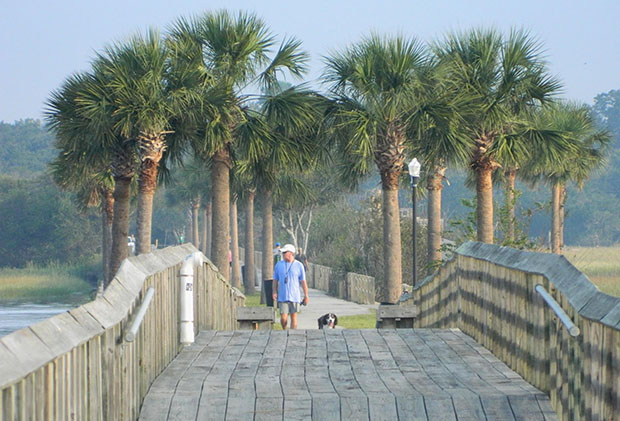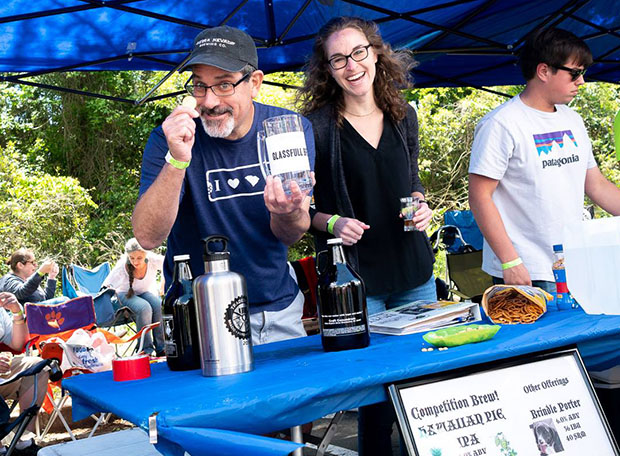Crossing East Cooper
05 Jul 2020
A trolley over the old Pitt Street Bridge was the hottest ride in town
Words and photos by Suzannah Smith Miles

It was originally called the Cove Inlet Bridge and later, the Pitt Street Bridge. Locals in Mt. Pleasant know it colloquially simply as the “old” bridge. The bridge itself has been gone since 1940. Yet the causeway leading to the former trolley bridge joining Mount Pleasant with Sullivan’s Island now enjoys a superb new purpose as one of the most beautiful maritime public spaces in the Lowcountry.
Residents and visitors on the pedestrian bridge have the ability to get an up-close and personal view of the surrounding marshlands, shore bird life, and magnificent views of the harbor and the Charleston skyline beyond.
It’s a spectacular view with a rich history. The first bridge that crossed the area between the mainland and Sullivan’s Island (a waterway formerly called “The Cove”) dates to the Revolutionary War. Built in 1778 under the direction of one of Charleston’s great patriots, Christopher Gadsden (also designer of the “Don’t Tread on Me” flag), Gadsden’s Bridge was built to support the soldiers under William Moultrie at Fort Sullivan, (later Fort Moultrie.)
An engineering feat for its time, the bridge was a mile long, 18 feet wide, and overlaid with sheets of iron to handle the weight of troops, horses and cannons.
Gadsden’s Bridge lasted the war but only its supports remained by the early 1800s. It was likely taken by the hurricane known as the Great Gale of 1804.
Another short-lived bridge was built during the Civil War to support the Confederate troops at Fort Moultrie. Yet this bridge was gone by 1866, a casualty of war. For most of the 19th century, the only way to get on or off Sullivan’s Island was by boat.
This changed in 1897 when a consortium of businessmen under the farsighted leadership of Dr. Joseph S. Lawrence purchased the barrier island called Long Island just north of Sullivan’s Island in 1875 for a whopping $50,000.
Called the Long Island Development Company, the plan was to transform the wilderness island into one of the most popular resorts on the eastern seaboard with a new, exotic-sounding name—Isle of Palms.
Wrote the News & Courier, “It had lain there, that useless strip of sandy jungle, throughout the years. People saw in it nothing more than this and called it ‘Long Island.’ Lawrence saw in it ‘The Isle of Palms’—a source of pleasure and profit to the entire community.”
A grand hotel was planned; also a seaside boardwalk with a carousel and Ferris wheel and other amusements similar to those found at New York’s Coney Island.
The problem was getting people to the island and back again. Hence was born the Charleston & Seashore Railroad Company. This included both the establishment of a dedicated ferryboat service between Charleston and Mount Pleasant and one of the most modern inventions of that time—an electric railway. It was a state-of-the-art trolley system to carry people from Mount Pleasant to Sullivan’s Island and Isle of Palms.
The New York double-ender ferryboat Commodore Perry was purchased for the harbor ferry service. Trolley cars were also purchased—elegant, comfortable cars with interiors of mahogany. The challenge was building the trolley railway itself. It meant erecting not one, but two trestle bridges, one to cross Cove Inlet and the other over Breach Inlet between Sullivan’s Island and the Isle of Palms.
Rather incredibly, all was accomplished in under a year. Actual work started in February 1898; the resort had its grand opening in late July, less than six months later. When the first trolleys rolled across the Cove Inlet Bridge during the inaugural weeks of opening, they carried thousands of people from Charleston eager to experience this fabulous new resort.
One of the few descriptions of what it was like to ride across the Cove Inlet trolley bridge was written about in October 21, 1898 in the News & Courier by an elderly Charleston gentleman who signed his name “Old Croaker.”
After debarking the ferry in Mount Pleasant, passengers boarded the trolleys for the ride down Pitt Street. “Our old heads spun from side to side, vainly trying to take it all in… no doubt the little village will develop into a town ere long, with the easy access to and from the city. The motorman kept his rapid, steady speed even while crossing the long bridge over the wide strip of marsh and creek that separates the mainland from Sullivan’s Island. We could not but think of the little row boat of former years that used to ferry the passengers across this place.”
By 1923, and with the rising popularity of automobiles, the wooden bridge was widened to allow room for motor cars. By 1927, the trolley was no longer needed and the bridge, now dedicated solely to cars, became a vehicular bridge known as Pitt Street Bridge.
By 1936, the bridge had become inadequate and dangerous for the increasing traffic demands. Moreover, a new challenge had emerged—the creation of the Intracoastal Waterway. Given the Pitt Street Bridge’s narrow old-trolley one-car width, it was decided to build an entirely new, two-lane causeway to the island and erect a modern swing bridge that could open for large boat and barges. When the present Ben Sawyer Bridge opened in 1945, the old Pitt Street Bridge over Cove Inlet was dismantled.
Remains of the old bridge supports are still there, now favored by brown pelicans and other shorebirds as safe resting places for drying their wings, preening their feathers and taking a sunny snooze. A wooden walkway with a pier at its terminus is favored by fishermen for catching trout, bass and flounder.
The park has evolved over the last several decades with continued improvements. It is now officially designated as the Pickett Bridge Recreation Area in memory of Dr. Otis M. Pickett and his wife, Ruth. These two beloved citizens served the East Cooper area for over 40 years from his doctor’s office on Pitt Street, next to the Pitt Street Pharmacy.
Indeed, the “old” bridge is one of the best examples of positive repurpose in the Lowcountry, situated at the very end of Pitt Street in Mt. Pleasant. There are few places like it. Part of its splendor is its unpretentiousness. As a place to walk, to jog, to ride a bike or simply sit on one of the benches and enjoy the fresh salt air, it views are unbeatable.












